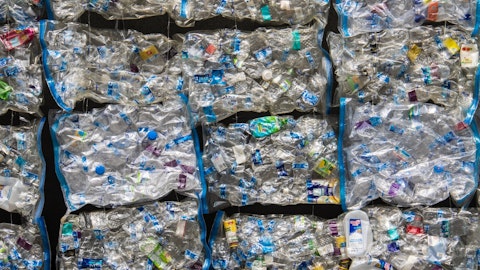Michael McMurray : And then what I would remind investors is that the fourth quarter is typically seasonally weak to the third. Just as a reminder.
Operator: Our next question comes from the line of Aleksey Yefremov with KeyBanc Capital Markets.
Aleksey Yefremov : Government in China recently included the plastics industry, specifically in their economic support program, just very recently. Do you have any insight into how the support actually is implemented in practice. It sounds like you haven’t seen much benefit so far. But — just any color on specific program maybe that you have would be helpful —
Peter Vanacker: Yes, Aleksey, I mean, we have seen a couple of areas where that eventually could have an impact. But at this point in time, it’s too premature to say, I mean how much that impact will be. Our people, as you know, they are on the ground, I mean, following that. There seems to talks around, I mean, automotive industry, talks about white goods industry, but too premature, I mean, to say because we need — we’ve seen a couple of these initiatives so far, but we are rather in a wait-and-see position now and ready. I mean, if the market would see, I mean, an uptick because all the initiatives so far have not had the impact as we would have hoped despite the fact, I mean, that the saving rates of individuals is extremely high, I mean, in China.
Operator: Our next question comes from the line of Frank Mitsch with Fermium Research.
Frank Mitsch : I had a question on I&D. You noted in your slide that you’re anticipating a $20 million headwind in 3Q from turnarounds, but also you indicated that you’re shutting down 2 PO/SM plants for both the months of July and August, I assume that that’s not included in that guide. So I’m just curious what sort of financial impact we should be anticipating with the shutdowns of the PO/SM facilities and are you awaiting a return in demand before you bring those facilities back up? Any more color there would be very helpful.
Peter Vanacker: Yes. Very good question, Frank. And of course, I mean, like we have done last year as well. We don’t call this, let’s say, cost savings, but I mean, we call this, I mean, we look at what is happening in the marketplace. You know that with our PO/TBA capacities and especially the new one that we have rather seen successfully. We have the lowest cost and also lowest carbon footprints, propylene upsides in the world. So it’s clear, I mean, that the PO/SM facilities are more kind of playing a role of a swing capacity. So with that, I will hand over to Kim to give more details.
KimFoley : Frank. Thank you, Peter. Let me just add a little bit more color, as Peter alluded to, when we provide the guidance, the guidance was really to help investors understand the difference of bringing on this new PO/TBA capacity and relative to the other capacity that we would be taking offline for maintenance. And we really looked at that from the PO/TBA technology. So that you can see both the PO impacts as well as the oxyfuel impacts because they’re almost offsetting, which is what you see in the guidelines. We talked about a 50% run rate for the new plant versus the maintenance of the other assets. So when you ask about what’s the impact of the PO/SM market or assets going down, I think the way to think about it is where is styrene today.
Styrene is oversupplied, it’s changing month-to-month on very, very thin margins. So what — how I would answer your question, Frank, is I don’t think there is an impact based on PO demand of those plants idling at this point in time based on the durable demand for polyurethanes regionally as well as globally.
Operator: Our next question comes from the line of Vincent Andrews with Morgan Stanley.
Vincent Andrews : Question within your wide range of EBITDA guidance, you have sort of a single point targets for operating rates. So I’m just wondering how you’re thinking about operating rates given they fluctuated a fair amount a lot more than normal over the past 12 months. And so what are you solving for with those operating rates versus the profitability you’re seeing?
Michael McMurray : It’s pretty simple, Vincent. We’re matching supply to demand. I wouldn’t say it any other way.




